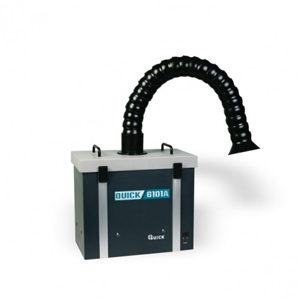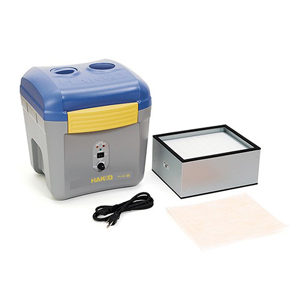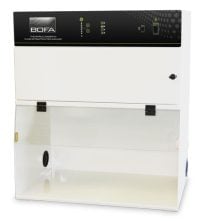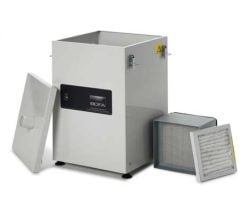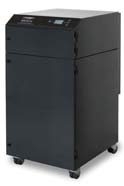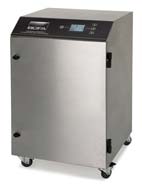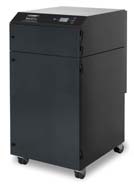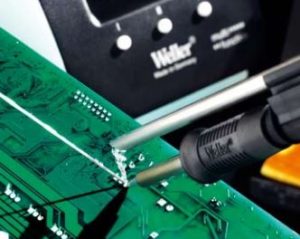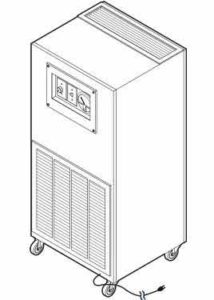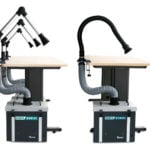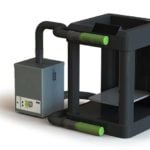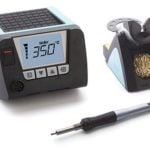Table of Contents
Here you’ll learn about soldering fans, fume absorbers, and fume extractor applications. Some may require a fan for soldering while others need a more advanced solution for laser engraving, solvent use, or 3D printing.
It’s important to have appropriate ventilation and filtration when fumes, particulate, or gases are produced as a result of soldering, rework, solvents, adhesives, or advanced manufacturing.
Does fume exposure for just a few hours a day require a fume extractor? Is your fume extractor really making a difference? What if it was actually making things worse?
Just decades ago, maximum daily exposure limits and multi-stage filtration were afterthoughts. Recent studies suggest connections between lead exposure, ultrafine particles, and low-quality air as contributors to cancer, respiratory ailments, and cognitive declines.
- 30 minutes exposure to airborne particles and gases per day is enough to cause health problems.
- 30 minutes exposure per day Means Approximately 110 hours/year or 14 workdays with continuous exposure to hazardous gases and particles. (Weller)
Continue to: Particulate Matter – What is it and how does it affect our health?
What’s In Soldering Fumes?
Smoke Means Particulate
Smoke is the result of airborne particulate. The particles are so small that they become buoyant (~10 microns). Most particles become invisible to the naked on around 60 microns, about the same size as a particle of dust only visible in a beam of light. It’s possible that 95% of soldering emissions are actually particulate based. So, a carbon filter, while important, may only remove 5% of the total pollutants by volume, even assuming 100% capture of gaseous molecules.
Types of Solder Fans & Soldering Fume Extraction
Let’s consider some basic language when evaluating more advanced solder fume extraction designs and expected performance. Mechanisms differ between fume displacement, fume absorption, fume filtration, and fume extraction. Applications also differ in best-case scenarios, such as unique filtration designs for 3D printing, lasers, soldering/rework, and benchtop enclosures. Finally, we have some systems designed for single operator workstations, while others may be adept for up to a dozen operators, if not more. While not the subject of study here, it’s worth noting that some operations may benefit from a full room air evacuation and filtration system.
Balance a Fume Extractor by Your Needs and Cost
Whatever our budget or environment, something that gives you even limited fume filtration and exhaust routing is better than nothing. This post details both advanced filtration solutions while also highlighting the best low-cost fume extraction options for DIY and home-grown soldering operations. It’s important to recognize the basic limitations of low-end soldering fume extraction systems.
Continue to: Why Do I Need Fume Extraction?
DIY Soldering Fan Filter Units <$50
The Problem with Fume Extractors Under $50
One of the most common suggestions we see for DIY extraction fans is usually a $15 – $25 desktop fan with an activated charcoal impregnated filter. Obviously, the price, size, and relatively silent operation wins favoritism for hobbyist operations.
The value of a fume filtration system must consider whether purification and capture efficacy is sufficient for industry standards of air quality. The actual chemical capture rates of these thin, inline filters are rarely highlighted nor disclosed by manufacturers.
Studies on Soldering & Flux Fumes: Gas or Particulate?
Although dated, the study below demonstrates dramatic differences in particulate capture based on filter media. It notes of all the particles measured by an electron microscope,
“The foam filters fitted in units A and B were very inefficient against particulate. Although some deposit was seen on the filters, a penetration of over 80% was obtained for filter A and over 50% for filter B. The HEPA filters, from units C and D, performed well, with average penetrations of 0.034% and 0.096% respectively. Solder fume analysed using an electron microscope had a particle size range of around 0.5-5 fim although some particles had agglomerated into small clusters or chains up to 20 fim in length”
A. E. JOHNSON and R. C. BROWN -1998
The study goes on to say that no evidence of resin acids were detectable in gas chromatographs.
“No evidence of resin acids at the detection limit of the gas chromatograph was found in the vapour phase of the unfiltered fume. Vapours were sampled upstream and downstream of the filter, but again, no evidence of resin acids in vapour form was found.”
A. E. JOHNSON and R. C. BROWN -1998
This study should be weighted by age, material choice, and instrument limitations. However, it does support particulate matter being a more dangerous material in solder fumes compared to gas vapors. Actionably, a standard HEPA filter would effectively capture the entire range of particle sizes, at least to the degree detected in the tests.
Proponents of DIY fume extraction systems suggest it’s better than nothing. Critics suggest that without a dedicated HEPA and chemical capturing filter, DIY solutions will not provide a meaningful reduction in fumes, pollutants, or ultrafine particulates.
- Manufacturer’s fail to produce data of filtration efficacy
- CFM is not adequate for spot filtration across the surface areas
- Carbon impregnated filters do not capture fine particulate matter
- Unfiltered particles and aerosols get recirculated into the air
- Uncaptured particles and aerosols gravitate toward the user
- Pollution expands, deposits, and circulates throughout the HVAC, onto surfaces, and embeds within clothing, furniture, and floors
Technology gets cheaper daily, and it’s quite possible to build a DIY fume extractor at a relatively low cost. However, creating a multistage filter design with HEPA and chemical filtration is far more complicated. One must also consider the importance of ESD-safe materials and avoid damage to sensitive circuits or electronics.
Now that we’ve covered deficiencies in lower-end units, let’s consider different scales and upgrades as we move toward advanced fume extraction models.
<$80 | Fume Fan Filtration
The most common setup for a low-end fume fan extractor: an axial fan draws air through an activated carbon filter. The difference is generally a larger fan and housing which better supports air induction, has a larger surface area, and better retains pollution. Larger surface areas and better-documented fan filter rates provide a more accurate assessment of surface area coverage and filtration efficacy.
It’s common for these units to feature conductive materials which make them safe for soldering sensitive electronics components without risk of electrostatic-discharge (ESD).
Haako makes a well-regarded mid-entry fume absorber at an affordable price point. $70 for the fume extraction unit and $25 for a 5 pack of carbon filter replacements are both well-priced options.
One reason PAC suggests the FA-400 from Haako is for its configurable position that offers either a better CFM rating or wider coverage range. The low profile position increases efficiency and airflow (~2.6X). The unit stands upright for a wider area (17.7 CFM) or lays face down for better on-spot suction (38.8 CFM) — these metrics are measured without (w/o) filter — results vary based upon filter blockage and use.
An industry-standard activated carbon filter (PN: A1001) absorbs up to 80 percent of the odors from the air and is easy to replace.
The most common downside of the Hakko FA-400 and similar models: air flow capacity is limited and sometimes not adequate in turbulent air conditions. This is a great solution for occasional soldering projects but not ideal for someone who spends multiple hours per week within or nearby areas exposed to soldering fumes.
It’s important to remember that air quality not only affects the users, but also impacts the encompassing area as drafts and currents propagate solder pollution around the room — even to those who are not nearby the source. For this reason, its worth investing into an adequate filtration system for the room size and volume of work.
Hakko Fume Extractor Reviews:
Review: Hakko FA-400
Review: Hakko FA-430
< $100 | Fume Extraction Units
Weller also makes a well-regarded fume filtration unit for a few dollars more. The Weller advantage here is that it provides a significantly better CFM rate, between 87 – 107 CFM. This is a good choice if you find yourself soldering more frequently.
< $500 | Benchtop HEPA Gas Fume Extraction
A benchtop HEPA gas extraction unit is designed for use directly on a benchtop with a moderate flow rate. The Metcal BVX-103-S is well priced in this range and just below $450. The model is also available with ESD plenum adapters and connection hoses 72″ | 144″.
< $700 | Mid-High Range Fume Extractor Units
The most common feature you’ll see with a commercial fume filtration unit are multi-stage inline HEPA filters, pre-filters, and inline carbon-activated filters. A prefilter is common for removing larger particles and improving the lifecycle of more expensive HEPA filters.
We’ve covered most of the mechanics and data behind carbon / HEPA combination filters in previous posts.
Weller ZERO SMOG Systems
Weller’s zero-smog technology is largely targeted at improving air quality and improving emissions quality in commercial industrial environments. A broader filter range and spot filtration arm/nozzle ensure the closest possible extraction point to the source and better capture efficacy.
Weller provides unique filtration options via wide-band gas filters which enlist a 50% active carbon and 50% puratex for better filtration among molecules of both high-molecular-weight (carbon focus) and low-molecular-weight (Purtex focus). Puratex is advantageous in the conversion of a large number of chemical pollution into non-polluting gases via molecular modification.
In cases where extracting adhesive fumes and solvent gases are most impactful, particulate filtration is not always necessary. Therefore, chemical-absorption-only options reduce overall expenditure and long-term filter replacement costs.
Single or dual-nozzle design is a 117 CFM unit which allows dual placement on a single or double user workstation during soldering, rework, adhesive applications, or 3D printing.
The BVX-201-KIT is a two operator, PRE-HEPA-GAS volume extraction system with two BVX-ARML designed for dual workbenches. Audible alarms indicate filter replacement.
PACE offers a dual user or dual workstation fume extraction system with a 130 CFM airflow and quiet operation. Select 2″ or 3″ evacuation hose for multiple configurations and air flow needs.
Hakko provides a three-stage filtration unit is available with multiple hose exaction sets for spot filtration. Filter replacement indicators on the front panel notify you of filter replacement.
> $700 | High-End Fume Extraction and Fume Absorption Units $700+
Fume absorption units scrub dirty air and reintroduce air back into the working environment after HEPA and chemical filtration.
High-end soldering units feature multi-user configurations and operation-specific features. For example, specialized fittings for 3D printers, laser engraving industries, heavy-duty industrial use, SMART sensors for flow and filter blockage, and computer-aided adjustments for better efficiency and quality assurance outcomes.
Related Post: Advanced Guide to 3D Printing Fume Extraction | Odors & Particulates
BOFA CAB 700 Fume Extractor Cabinet
BOFA partial enclosure fume hood extraction is an option for a variety of applications. The FumeCAB 700 features an integrated filtration system which exhausts fumes and vapors. The easy change filter design enables safe and simple front loading filter replacement. Ultra-bright slim-line energy saving LED lights come as standard with optional UV lighting. UV lighting is ideal for applications such as the conformal coating of PCBs for identification of uniformity issues.
Fume Tip Extraction
The BOFA T15 is a high volume fume extraction system with a built-in silencer for extremely low noise levels. With its three-stage filtration and filter warning indicator, this is a true industry favorite, suitable for 5 -15 operators/extraction points. The T15 extracts and filters fumes and debris through small bore hoses and attachments. Ideally, this system is suited for multiple workstations with soldering iron tip extraction, vac pens and any application requiring close proximity use.
When you purchase a fume extractor from PAC, you’ll receive a number of value-added services including end-to-end product support from application experts. We evaluate your production environment, product sensitivity, and provide product solutions for any standard of air quality or exposure guidelines. We stand 100% behind all of our products, which means we’ll also facilitate replacements in the rare case that a product arrives damaged or defective.
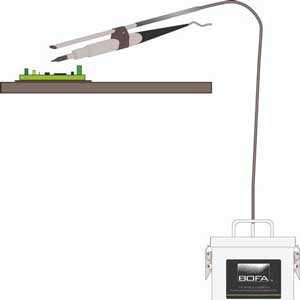
Every high-end fume extractor contains a multi-stage filter system, at least those which return filtered air back to the working environment. The HEPA filter removes 99.99% of particulates while the carbon filter removes noxious or toxic gases and aerosols. A plenum design provides a containment area for air upstream of the filter which improves the retention rate of inducted air. Air flows more evenly at a more consistent pressure across the face of the filter, thus improving the overall surface area coverage and maintains induction efficiency.
Fume Extraction Soldering Iron Attachments
Extraction handpieces (tip extraction): The advantage here is that pollution is removed at the source before it can spread around the room by air currents. Because the top moves with the handpiece, extraction coverage is more dynamic than a stationary unit. Regardless of whether your tinning, applying solder, or resting the handpiece, the air exhaust is always just a few centimeters from the source. Because the tube is so small, you can run this hose further to an external exit with a relatively small pump to a cracked window, under a door ect.
When you purchase any fume extraction products from PAC, you’ll receive a number of value-added services including end-to-end product support.
We stand 100% behind all of our products, which means we’ll also facilitate replacements for damaged or defective items.
Other Filtration and Fume Extraction Variables
Existing Air Currents and Combined Forces
In non-controlled environments, we know that particles and aerosols travel long distances and remain buoyant for long periods. Fan blowers without effective capture and filtration systems may do more harm than good, including spreading or stirring pollution/particulates directly toward the user or to adjacent living areas/HVAC systems in residential environments.
If hazardous or noxious gases are not of concern, a standalone HEPA purifier with external exhaust is a popular choice.
HEPA Air Purifier with Germicidal Light
The CleanPro® HEPA Air Purifier helps prevent the spread of airborne contaminates, and is ideal for hospital, healthcare, clean room and other critical environments. Built with a durable white powder coat finish, it blends into the decor of a hospital or healthcare facility.
Variable Speed Control
Airflow with top-mounted discharge grille or optional adapters that for integrated or external discharge.
Germicidal Lamp
UV light helps kill bacteria and viruses in the airstream, especially extremely small particles .
Tamperproof Controls
All of the controls for the unit are located under a clear, tamper-proof cover.
Easy to Move
CleanPro® HEPA Air Purifiers are equipped with four casters, making it easy to move. The casters can be locked to prevent movement.
Replaceable Filters
Prefilters are replaced by removing the front grille. The HEPA filter is replaced by removing the rear access panel.
Fan Configuration
Fan configuration is important. Exhausting fumes upward into the air or towards the user may be more harmful if particles would otherwise settle. Blowing any extraneous fumes or particulates back into the air is not a good idea. Eventually, they will settle on surfaces, furniture, chairs, carpeting, floors, ect with widespread accumulation. Particles that settle onto nearby surfaces are easily disturbed and recycled into the air, whether by physical agitation, natural air currents, or HVAC.
Exposure Over Time
Even for a couple of hours a day, that’s 10 – 14 hours a week…that’s a lot of time spent in what is probably really dirty, if not toxic air. The smell is just a matter of concentration by PPM and many toxic gases will not produce odors at harmful exposure levels. Other chemicals do not produce odors at dangerous PPM levels.
Distance
The most influential factor is the distance of the exfiltration from the production source. For example, the face velocity in front of an extraction system will fall by 1/10 at one diameter from the face of the filter.
Material Composition and Surface Size
For any filtration system, consider not only CFM, but also the size of the area, and filter efficacy. Environmentally, the wire thickness, metal/flux ration, material composition, and material temperature incur variability. Air current from other fans, HVAC, or windows will also influence the solder exhaust flow.
Turbulence
Turbulence prevents directional extraction of the fumes, which means they spread everywhere. It’s also throwing up any non-filtered particulates into the air.
Ultrafine particles might be as problematic as the gaseous chemicals. Ultrafine particles will not settle and are so light that they suspend in the air until exhausted or they settle on a surface. Eddies or agitation can keep them suspended for days, if not perpetually.
Avoid Counterfeit Soldering Products
Remember, these products are commonly counterfeited. If you find imported products from imports like Haako or Weller for half the price, it’s likely you’re looking at a counterfeit. Most established soldering brands require minimum-advertised-pricing (MAP) for resellers, so the lowest online price for a single unit is fixed. The best option is buying from an established factory-direct distributor.
Browse Fume Extraction Units by Industry and Application
View All Fume Extraction Units and Configurations
Related Posts
-
3D Printing Fume Extractors for Odors and Particles
Does a HEPA filter capture ultrafine particles (UFPs). What toxins does 3D printing produce? Why should every 3D printer have both a activated carbon and HEPA filter?
-
BOFA Fume Extractors for 3D Printing
3D printers are known to produce a number of byproducts during operation. Common 3D printing filaments such as ABS and PLA are known as high emitters of ultra-fine particulates (UFPs), while nylon and PCTPE are…
-
Hakko FA-430 Fume Extraction System
The Hakko FA-430 Fume Extraction unit is expressly for use at soldering stations, extracting the contaminated air directly at the source. Contaminated air is captured from the workplace surrounding the soldering station by the hood…
-
Why Do I Need Fume Extraction?
There are many applications where fume extraction is necessary and/or required by law. Manufacturing and assembly operations, repair centers, salons, ect. Anywhere where there are harmful fumes and particles in the air that can be…
-
Hakko FA-430 Fume Extraction System
The Hakko FA-430 Fume Extraction unit is expressly for use at soldering stations, extracting the contaminated air directly at the source. Contaminated air is captured from the workplace surrounding the soldering station by the hood…
-
Why Do I Need Fume Extraction?
There are many applications where fume extraction is necessary and/or required by law. Manufacturing and assembly operations, repair centers, salons, ect. Anywhere where there are harmful fumes and particles in the air that can be…
-
BOFA Fume Extractors for 3D Printing
3D printers are known to produce a number of byproducts during operation. Common 3D printing filaments such as ABS and PLA are known as high emitters of ultra-fine particulates (UFPs), while nylon and PCTPE are…
- Metcal MX-5000 Soldering System
The new MX-5000 Series Soldering & Rework System is the next generation of the trusted Metcal Soldering Systems that will enable you to increase productivity and process control for a wide range of applications with…
-
A Compact Review of Weller's WT Soldering System
According to Weller, the WT soldering stations represent the world’s first soldering system with replaceable, passive, high-performance soldering tips.
-
Everything You've Ever Wanted to Know About Soldering
We ran into this fantastic soldering demo on YouTube using PACE equipment. View Production Automation's YouTube Channel View all the PACE products Production Automation offers


